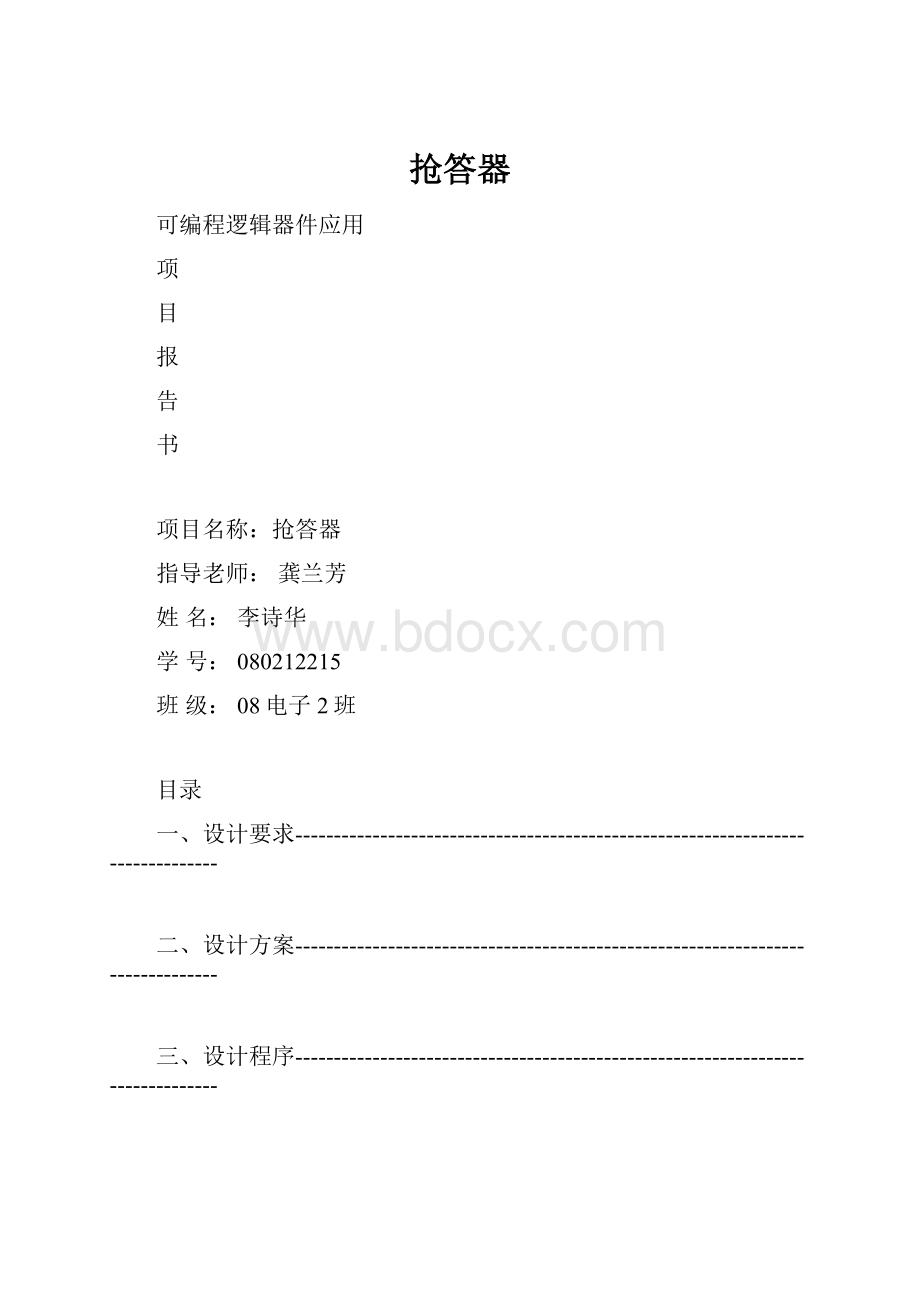抢答器.docx
《抢答器.docx》由会员分享,可在线阅读,更多相关《抢答器.docx(14页珍藏版)》请在冰豆网上搜索。

抢答器
可编程逻辑器件应用
项
目
报
告
书
项目名称:
抢答器
指导老师:
龚兰芳
姓名:
李诗华
学号:
080212215
班级:
08电子2班
目录
一、设计要求--------------------------------------------------------------------------------
二、设计方案--------------------------------------------------------------------------------
三、设计程序--------------------------------------------------------------------------------
四、管脚分配---------------------------------------------------------------------------------
五、硬件下载实现现象描述-----------------------------------------------------------
六、体会与收获-----------------------------------------------------------------------------
一、设计要求
1.具有第一抢答信号的鉴别和锁存功能。
在主持人发出抢答指令后,若有参赛者按抢答器按钮,则该组指示灯亮,显示器显示出抢答者的组别。
同时,电路处于自锁状态,使其他组的抢答器按钮不起作用。
2.具有计时功能。
在初始状态时,主持人可以设置答题时间的初始值。
在主持人对抢答组别进行确认,并给出倒计时计数开始信号以后,抢答者开始回答问题。
此时,显示器从初始值开始倒计时,计至0时停止计数,同时扬声器发出超时报警信号。
若参赛者在规定的时间内回答完问题,主持人可以给出计时停止信号,以免扬声器鸣叫。
二、设计方案
从要实现的功能来看,层次化的设计会更加容易实现,将设计分为三个部分,第一部分用来实现第一抢答信号的鉴别和锁存功能,在主持人发出抢答指令后,若有参赛者按抢答器按钮,则该组指示灯亮,显示器显示出抢答者的组别。
同时,电路处于自锁状态,使其他组的抢答器按钮不起作用,第二部分用来实现在初始状态时,主持人可以设置答题时间的初始值。
在主持人对抢答组别进行确认,并给出倒计时计数开始信号以后,抢答者开始回答问题。
此时,显示器从初始值开始倒计时,计至0时停止计数,同时扬声器发出超时报警信号。
若参赛者在规定的时间内回答完问题,主持人可以给出计时停止信号,以免扬声器鸣叫。
第三部分是译码部分将主持人的设置的倒计时数值用数码显示出来。
三、设计程序
第一部分:
抢答模块
-------库-------
libraryieee;
useieee.std_logic_1164.all;
useieee.std_logic_unsigned.all;
useieee.std_logic_arith.all;
-------实体---------
entityjnbis
port(clk,i:
instd_logic;
u,r,t,y:
instd_logic;
led3:
outstd_logic_vector(3downto0);
k:
outstd_logic_vector(2downto0);
o:
outstd_logic_vector(3downto0));
end;
--------结构体---------
architectureoneofjnbis
signaln:
integerrange0to1;
signalclk_1k,clk_100h:
std_logic;
signaldata:
std_logic_vector(3downto0);
signals:
std_logic_vector(6downto0);
signalh:
std_logic_vector(2downto0);
signalj:
std_logic_vector(3downto0);
begin
process(clk)
variablecnt1:
integerrange0to250;
variablecnt2:
integerrange0to100;
begin
ifclk'eventandclk='1'then
ifcnt1=250then
cnt1:
=0;
ifcnt2=100then
cnt2:
=0;
clk_1k<=notclk_1k;
else
cnt2:
=cnt2+1;
endif;
else
cnt1:
=cnt1+1;
endif;
endif;
endprocess;
process(clk_1k)
begin
ifi='1'then
ifn=0then
ifu='0'then
led3<="0001";
j<="0111";
n<=n+1;
elsifr='0'then
led3<="0010";
j<="1011";
n<=n+1;
elsift='0'then
led3<="0011";
j<="1101";
n<=n+1;
elsify='0'then
led3<="0100";
j<="1110";
n<=n+1;
endif;
endif;
else
h<="100";
n<=0;
led3<="0000";
j<="1111";
endif;
k<=h;
o<=j;
endprocess;
end;
第二部分:
数值输入模块
libraryieee;
useieee.std_logic_1164.all;
useieee.std_logic_unsigned.all;
useieee.std_logic_arith.all;
entityWERis
port(rst,clk,tsr,en:
instd_logic;
p:
outstd_logic;
c,d:
instd_logic_vector(3downto0);
duon:
outstd_logic_vector(5downto0);
led3:
instd_logic_vector(3downto0);
cout:
outstd_logic_vector(6downto0));
end;
architectureoneofWERis
signalt,r:
integerrange0to1;
signalw:
integerrange0to6;
signalclk_1k:
std_logic;
signalclk_100h:
std_logic;
signalcnt6:
integerrange0to3;
signaldata:
std_logic_vector(3downto0);
signaldout:
std_logic_vector(5downto0);
signals:
std_logic_vector(6downto0);
signalled1,led2:
std_logic_vector(3downto0);
begin
process(clk)
variablecnt1:
integerrange0to250;
variablecnt2:
integerrange0to100;
begin
ifclk'eventandclk='1'then
ifcnt1=250then
cnt1:
=0;
ifcnt2=100then
cnt2:
=0;
clk_1k<=notclk_1k;
else
cnt2:
=cnt2+1;
endif;
else
cnt1:
=cnt1+1;
endif;
endif;
endprocess;
process(clk)
variablecnt1:
integerrange0to5000;
variablecnt2:
integerrange0to5000;
begin
ifclk'eventandclk='1'then
ifcnt1=5000then
cnt1:
=0;
ifcnt2=5000then
cnt2:
=0;
clk_100h<=notclk_100h;
else
cnt2:
=cnt2+1;
endif;
else
cnt1:
=cnt1+1;
endif;
endif;
endprocess;
process(clk_1k)
begin
ifclk_1k'eventandclk_1k='1'then
ifcnt6=33then
cnt6<=0;
else
cnt6<=cnt6+1;
endif;
endif;
endprocess;
process(cnt6)
begin
casecnt6is
when0=>dout<="111110";
when1=>dout<="111101";
when2=>dout<="111011";
whenothers=>null;
endcase;
endprocess;
process(dout)
begin
casedoutis
when"111110"=>data<=led1;
when"111101"=>data<=led2;
when"111011"=>data<=led3;
whenothers=>null;
endcase;
endprocess;
process(clk_100h)
begin
iftsr='0'then
led1<="0000";
led2<="0000";
t<=0;
else
ifrst='0'then
t<=1;
p<='0';
led2<=c;led1<=d;
elsifclk_100h'eventandclk_100h='1'andt=1then
ifen='1'then
if(led1<="0000")then
led1<="1001";
led2<=led2-1;
if(led2<="0000")then
led1<="0000";
led2<="0000";
ifw<=5then
p<='1';
w<=w+1;
else
p<='0';
endif;
else
p<='0';
endif;
else
led1<=led1-1;
endif;
else
t<=t-1;
endif;
endif;
endif;
endprocess;
process(data)
begin
casedatais
when"0000"=>s<="0111111";--0
when"0001"=>s<="0000110";--1
when"0010"=>s<="1011011";--2
when"0011"=>s<="1001111";--3
when"0100"=>s<="1100110";--4
when"0101"=>s<="1101101";--5
when"0110"=>s<="1111101";--6
when"0111"=>s<="0000111";--7
when"1000"=>s<="1111111";--8
when"1001"=>s<="1101111";--9
whenothers=>null;
endcase;
endprocess;
duon<=dout;
cout<=s;
end;
第三部分:
译码模块
libraryieee;
useieee.std_logic_1164.all;
useieee.std_logic_unsigned.all;
useieee.std_logic_arith.all;
entityyimais
port(h:
instd_logic_vector(6downto0);
a,b,c,d,e,f,g:
outstd_logic);
end;
architectureoneofyimais
begin
g<=h(6);
f<=h(5);
e<=h(4);
d<=h(3);
c<=h
(2);
b<=h
(1);
a<=h(0);
endone;
总体框图:
四、管脚分配
五.硬件下载实现现象描述
和预想的效果一样。
当主持人按下复位开关时,四个按键开关生效。
选手开始抢答。
抢答完后,显示管显示选手的号数。
这时主持人可以设置答题时间的初始值此时,显示器从初始值开始倒计时,计至0时停止计数,同时扬声器发出超时报警信号。
若参赛者在规定的时间内回答完问题,主持人可以用开关给出计时停止信号,以免扬声器鸣叫。
六、体会与收获
这次实验虽然要实现的功能比较多,看起来仿佛也比较复杂,但是我们用了层次化来设计程序以后,才发现其实也不是很复杂,把程序分成三个模块来设计,设计起来明显降低了难度。
只是在连接总体框上需要我们熟悉数电的知识,不过在翻阅资料后,问题都一一解决了。